Categories: Featured Articles » Electrician at home
Number of views: 42317
Comments on the article: 13
The principles of operation of grounding systems for buildings TN-C and TN-C-S
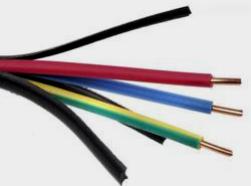 The issues of safe use of electricity continue to become increasingly relevant for the entire population. The requirements of an international electrical company, implemented by regulatory documents in our country, have tightened the rules for the operation of electrical equipment. After that, state standards in force since Soviet times with simplified rules for grounding electrical circuits for residential buildings were revised.
The issues of safe use of electricity continue to become increasingly relevant for the entire population. The requirements of an international electrical company, implemented by regulatory documents in our country, have tightened the rules for the operation of electrical equipment. After that, state standards in force since Soviet times with simplified rules for grounding electrical circuits for residential buildings were revised.
However, a large mass of buildings continues to be operated according to the old TN-C scheme. To re-equip it with the TN-C-S system requires enormous material costs, it is not easy to accomplish all this nationwide. Therefore, such work is carried out gradually, but systematically.
In the article "Classification of grounding systems of electrical installations" the definition of electrical circuits for power supply of residential buildings and industrial facilities is given, a description of the TN-C and TN-C-S systems is given. Let's consider them a little more in detail.
Old circuit
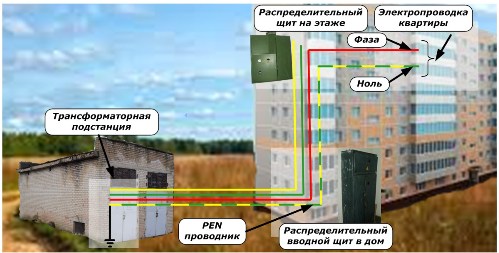
Schematic diagram of the building's power supply system TN-C
The picture shows that PEN conductor ground (color yellow-green) is made by a circuit located at a transformer substation, and nothing more. Nowhere else are any land connections applied.
Each apartment receives only zero, which is actually the same PEN conductor and phase. That is, only two wires from the distribution panel, located on the floor for several apartments, come into the apartment.
Between the switchboards of the floor and the house, four-core power cables are laid, transmitting three phases along the wires and one common zero. The same power cable, only of greater power, connects the electrical equipment of the transformer substation with the switchboard of the building.
Modified circuit
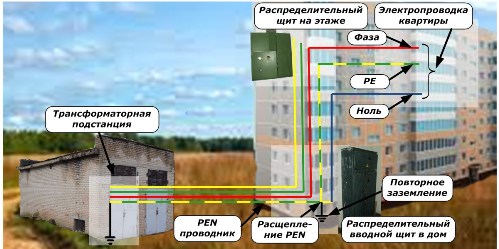
Schematic diagram of the building's power supply system TN-C-S
The cable laid from the transformer substation to the switchboard at the entrance to the building remained unchanged in it. Everything else has been revised. The PEN conductor connected to its bus is divided into two lines: PE (yellow-green) and N (blue). In practice, this method is called by electricians “splitting”.
It is shown in the picture below.
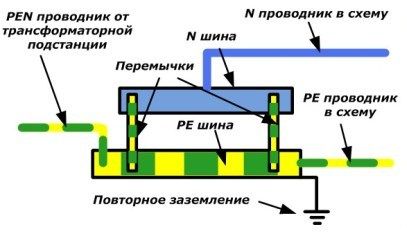
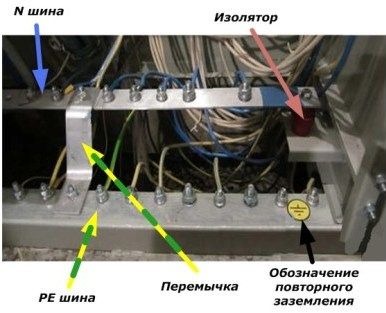
The splitting principle PEN conductor
It shows that the cable end of the PEN conductor from the TP is connected to the PE bus, which is re-grounded. All PE conductors in the building's electrical circuit depart from it.
The common zero bus N is installed on the insulators inside the switchboard of the building and connected to the PE bus with two jumpers located at the edges. N conductors are connected to their bus, and then go further from it to the circuit.
The correct implementation of such a circuit eliminates the loss of the PE ground conductor due to damage to zero or any manipulations with it both inside the building and at the transformer substation.
Common mistakes and advice to the home master
The good intention of owners of apartments equipped with wiring operating according to the TN-C scheme to comply with the recommendations on the grounding of electrical appliances is often accompanied by serious violations of the rules that can cause great harm to people around. Consider the typical errors of self-connecting devices.
We will immediately agree that we will not consider the issues of using protective devices and automation here. This is the topic of a separate article. She set out here.
Connecting electrical appliance housings to zero
This method is called zeroing.It was widely used as a protective device when performing short-term work with an old power tool equipped with a metal body with poor insulation. Modern industry does not produce such devices.
Principle of operation: in the event of insulation failure and the appearance of a phase potential, a short circuit current occurs on the case, which is quickly turned off by circuit breakers.
The dangers of grounding:
-
the absence of well-tuned protective devices in case of damage to the device does not exclude the appearance of a dangerous potential in a person in contact with the body;
-
sometimes "electricians" make mistakes by confusing phase with zero. In this case, the phase will be deliberately brought to the housing;
-
in cases of damage to zero, the circuit does not work.
Connecting electrical appliance cases to metal building structures
Water supply networks, water heating mains, elevator equipment shaft housings and some other elements are permanently located in the ground. Folk "craftsmen" use them for grounding.
Method Risks:
-
electrical contact with earth is not controlled;
-
in case of repair of pipelines, the circuit breaks;
-
plastic pipes mounted by sections work as insulators;
-
when the potential appears on the device’s case, an accidental person in any apartment may be injured, touching the heating battery, water tap and finding himself in the path of current passage.
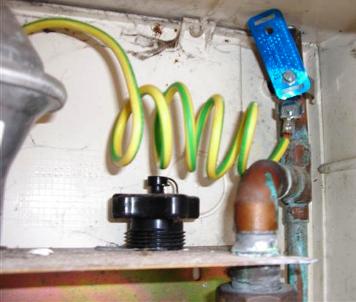
Unauthorized splitting of the PEN conductor on the floor shield
At first glance, this method seems to be the most optimal solution. The electrical wiring of the apartment is redone according to a three-wire scheme for connecting zero and PE conductor in strict accordance with the rules. It remains only to connect to the ground loop and the "home electrician" independently does the splitting on the floor distribution panel.
This is dangerous because:
-
the approved and completed electrical wiring project of the entire building is grossly violated;
-
prerequisites for electrical injuries, threats of equipment damage are created;
-
in the event of any malfunctions in the wiring of the building, representatives of utilities can “appoint” the owner of the apartment as guilty, which will result in scandals, fines, checks by various commissions and other troubles;
-
housing and communal services electricians involved in building maintenance will not take into account the peculiarities of the modifications made during the work. This can be the cause of emergency situations.
Recommendations
It is not so difficult to carry out the process of transferring electrical equipment to a safe power supply circuit for owners of cottages and private houses. Enough for this create a separate ground loop, preferably from modern modular designs and connect to it via the TT system.
Residents of multi-storey buildings are more difficult to correctly resolve this issue. Splitting the PEN conductor into two components of the line is the task of the energy supply organization. It will be completed, but at different times.
At this point, during the repair of the premises, it is necessary to replace the old wiring with a new three-wire inside the apartment and prepare for the transfer of the circuit to the TN-C-S system. Leave the conductor removed from the apartment PE in readiness for connection to the housing and communal services electricians.
Read also on this topic:How to determine the type of grounding system in the house
See also at e.imadeself.com
:
